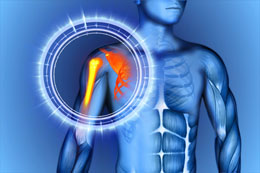In this article today, we would study about some basic facts of winged scapula treatment. The article would also abreast you with other aspects of this condition.

Winged scapula is one of those medical conditions, which, although common in most people, can still get ignored or unattended. This is mainly due to the almost asymptomatic nature of the disorder, which causes a person to overlook it, even if he is suffering from it. The condition is associated with an impaired function of the shoulder, and also with poor posture. It is basically used to refer to a condition wherein, the shoulder, instead of lying flat against the back of the chest wall, stay in a protruding position. The disorder is called so because, the inner border of the scapula (shoulder blade), takes a wing-like appearance. This article will focus on the winged scapula treatment, as well as its causes and symptoms.
Causes and Symptoms
One of the most complex parts of the shoulder is the scapula, which is the largest bone in the entire build of the shoulder. The reason the arm is stabilized to the body and has a wide range of motion, is due to the fact that the scapula is attached to a huge number of muscles. Now, all these muscles work in harmony, and allow the arm to move around in various directions. However, because of certain factors, some of these muscles may malfunction. This in turn may disrupt the working of the scapula. And one of the repercussions of this may result in the condition in question.
There is something called the thoracic nerve (spinal nerves emerging from the thoracic vertebrae) off the shoulder. Now, the primary job of this nerve is to support the serratus anterior muscle (this muscle is required to pull the scapula forward). So, if the thoracic nerve sustains any injury, it affects the serratus anterior muscle, which eventually results in a winged scapula. There could be various ways through which the thoracic nerve may get damaged. Common ones include blow to the neck or shoulder, indulging in repetitive movements, like digging, car washing, etc., and even medical treatments. A sudden twist of the neck or shoulder, may also damage the nerve.
As far as the symptoms are considered, as mentioned, the condition is an almost asymptomatic one. However, the affected person may complain of having a feeling of pressure on his scapula, especially while sitting. Another symptom is one that is the most prominent, and that is a protrusion of the shoulder blade. And if the condition has been caused due to an injury, then there might be a constant pain accompanied by limited range of motion of the arm.
Treatment Plan
Treating this problem does not encompass only one method. This condition can be dealt with a combination of medical procedures and exercises. According to what experts recommend, a wait and watch approach, combined with physical therapy is the right treatment to deal with the condition. However, if this method does not respond well, and if the symptoms seem to stay for a good period of more than 3 - 6 months, then surgery may be necessary. In the surgery, the scapula is fixed to the rib cage. Speaking of the exercises, experts recommend patients to go for pressing against a wall, and punching. For the first work out, stand an arm's length apart from a wall. Now like you do push ups, lean against the wall, bend your arms and push away. This has to be repeated for 10 times per set. Doing 3 sets everyday is considered beneficial. Giving short jab punches to a punch bag, also help improve the disorder, and so, do bench press and shoulder press exercises.
These kinds of exercises actually help in the winged scapula rehab, and it is recommended to perform them under the supervision of a medical professional. To conclude, exercises are considered to be the first line of treatment, as with their help, the weakened muscles can be strengthened, thus improving the thoracic nerve and the serratus anterior muscle. Such exercises, when done regularly and in the right manner, restore the normal shoulder mobility in no time.
Disclaimer:
This Buzzle article is for informative purposes only, and should not be used as a replacement for expert medical advice.


 Winged scapula is one of those medical conditions, which, although common in most people, can still get ignored or unattended. This is mainly due to the almost asymptomatic nature of the disorder, which causes a person to overlook it, even if he is suffering from it. The condition is associated with an impaired function of the shoulder, and also with poor posture. It is basically used to refer to a condition wherein, the shoulder, instead of lying flat against the back of the chest wall, stay in a protruding position. The disorder is called so because, the inner border of the scapula (shoulder blade), takes a wing-like appearance. This article will focus on the winged scapula treatment, as well as its causes and symptoms.
Winged scapula is one of those medical conditions, which, although common in most people, can still get ignored or unattended. This is mainly due to the almost asymptomatic nature of the disorder, which causes a person to overlook it, even if he is suffering from it. The condition is associated with an impaired function of the shoulder, and also with poor posture. It is basically used to refer to a condition wherein, the shoulder, instead of lying flat against the back of the chest wall, stay in a protruding position. The disorder is called so because, the inner border of the scapula (shoulder blade), takes a wing-like appearance. This article will focus on the winged scapula treatment, as well as its causes and symptoms.